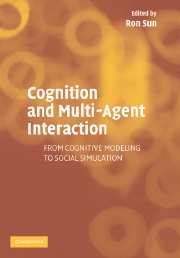Book contents
- Frontmatter
- Contents
- List of Contributors
- Preface
- PART 1 INTRODUCTION
- PART 2 OVERVIEWS OF COGNITIVE ARCHITECTURES
- PART 3 MODELING AND SIMULATING COGNITIVE AND SOCIAL PROCESSES
- PART 4 A SYMPOSIUM
- 15 Cognitive Science and Good Social Science
- 16 Collective Cognition and Emergence in Multi-Agent Systems
- 17 Social Judgment in Multi-Agent Systems
- 18 Including Human Variability in a Cognitive Architecture to Improve Team Simulation
- 19 When Does Social Simulation Need Cognitive Models?
- Index
17 - Social Judgment in Multi-Agent Systems
Published online by Cambridge University Press: 15 December 2009
- Frontmatter
- Contents
- List of Contributors
- Preface
- PART 1 INTRODUCTION
- PART 2 OVERVIEWS OF COGNITIVE ARCHITECTURES
- PART 3 MODELING AND SIMULATING COGNITIVE AND SOCIAL PROCESSES
- PART 4 A SYMPOSIUM
- 15 Cognitive Science and Good Social Science
- 16 Collective Cognition and Emergence in Multi-Agent Systems
- 17 Social Judgment in Multi-Agent Systems
- 18 Including Human Variability in a Cognitive Architecture to Improve Team Simulation
- 19 When Does Social Simulation Need Cognitive Models?
- Index
Summary
INTRODUCTION
Game theory in its several variants can be viewed as a contribution to multi-agent modeling. One relevant development of classical game theory, Generalized Game Theory (GGT), entails its extension and generalization through the formulation of the mathematical theory of rules and rule complexes (Gomolińska, 1999, 2004; Burns & Gomolińska, 1998; Burns & Roszkowska, 2004). Informally speaking, a rule complex is a set consisting of rules and/or other rule complexes. Social theory concepts such as norm, value, belief, role, social relationship, and institution as well as game can be defined in a uniform way in terms of rules and rule complexes. This has led to a number of applications: among others, the formalization of social relationships, roles, and judgment and action modalities (Burns & Gomolińska, 2000; Burns, Gomolińska, & Meeker, 2001; among others); reconceptualization of prisoners' dilemma game and other classical games as socially embedded games (Burns, Gomolińska, & Meeker, 2001; Burns & Roszkowska, 2004); models of societal conflict resolution and regulation (Burns, Caldas, & Roszkowska, 2005; Burns & Roszkowska, 2005); rethinking the Nash equilibrium (Burns & Roszkowska, 2004); fuzzy games and equilibria (Burns & Roszkowska, 2004; Roszkowska & Burns, 2002); sociocognitive analysis (Burns & Gomolińska, 2001; Roszkowska & Burns, 2002); simulation studies in whichGGTis applied, for instance, in the formulation of multi-agent simulation models of regulatory processes (Burns, Caldas, & Roszkowska, 2005).
In the GGT approach, a well-specified game at time t, G(t), is a particular multi-agent interaction situation where the participating actors typically have defined roles and role relationships. Most modern social systems of interest can be characterized in thisway. That is, there are already pre-existing institutional arrangements or social structures shaping and regulating interaction (see Figure 17.2).
- Type
- Chapter
- Information
- Cognition and Multi-Agent InteractionFrom Cognitive Modeling to Social Simulation, pp. 409 - 416Publisher: Cambridge University PressPrint publication year: 2005
- 2
- Cited by



